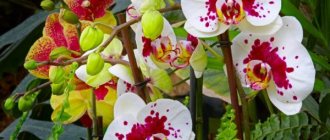Just a hundred years ago, only a few specialists could grow . Now they are not uncommon for many gardeners. And every year hundreds of new varieties appear, available for cultivation in apartments and private houses .
But subject to certain conditions. Including creating optimal lighting.
Anyone who is still poorly acquainted with orchids has lost a lot.
And you need to catch up on your knowledge about them:
- There is not a single plant in nature with such diversity. More than 30 thousand species;
- In the National Orchid Park in Singapore, visitors have the opportunity to see 60 thousand specimens ;
- It’s hard to even imagine the age. Millions of years. They have been admired for the last 3-4 thousand years. And they present it as an expensive and exquisite gift;
- Under natural conditions, they grow mainly in tropical areas. Mountains and forests : America;
- Africa;
- Australia;
- Southeast Asia.
- Very frequent tropical rains;
Orchid lighting option.
Proper lighting for orchids
Let's find out which phytolamp is suitable for orchids at home. In the tropics, daylight hours last quite long (12-14 hours). In our area in winter it is already dark at about 17:00. And at 7 am it is still dark. This darkness does not allow many species to grow and bloom :
- Chlorophyll (the green pigment in orchid leaves) converts sunlight into the energy the plant needs. And forms glucose and other organic compounds. Vital for plants: Chlorophyll A (blue-green) has the greatest activity in short blue wavelengths and long red wavelengths of light. Chlorophyll B is involved only in collecting sunlight;
- Regular lighting allows you to absorb blue waves throughout the day. Lunchtime is peak. There are no red waves at lunchtime. Only in the morning and evening.
Note! A lamp that is bright for our eyes can be very weak for a plant. And the weak one for our perception is the most suitable for an orchid.
- The best options for providing these colors with the necessary light : You can install each lamp separately: Turn on the blue one for daylight. This affects the creation of green mass;
- Red - with the arrival of darkness. They have a greater effect on flowering.
For each orchid it is necessary to choose a certain type of lighting.
- Some varieties love a lot of light and southern windows. And they demand it: Oncidium;
- Dracula;
- Dendrobium;
- Total time – 10-12 hours a day;
- If the flowers are installed away from the windows;
Important:
- Excessive artificial lighting brings little benefit. The leaves may turn slightly red. What is unacceptable in winter;
- The same leaves can indicate a lack of light. Their dark green color with a blue tint is evidence of this;
- It’s up to you to calculate your electricity costs.
Basic rules for caring for flowers at home
First of all, it should be remembered that the homeland of most orchids are countries with a uniformly warm climate, the temperature in which is not subject to significant fluctuations and always remains at a fairly high level. Also, do not forget about humidity and the length of daylight, which, as a rule, is at least 12 hours.
Knowing this, we can highlight the basic rules for caring for orchids :
- Flowers do not like it when they are too cold or too hot; the temperature in the room should be stable, but not exceed 30 degrees and not fall below 10.
- Plants need to be provided with high humidity, otherwise there is a risk that they will begin to dry out.
- Orchid roots need access to air, so the soil should not be dense, preferably, of course, special soil, selected depending on the specific type of plant.
- Periods of abundant watering must be alternated with periods of complete drying, as usually occurs in the natural habitat.
- All orchids need intense lighting; without it they will never actively grow and bloom. This condition is the most difficult to comply with, especially in winter.
Read more about the optimal conditions for keeping orchids in our material.
Power and types of backlight lamps
What light is suitable for orchids at home? Our scientists and specialists calculated the required amount of light
- Lighting means should not be heating . The total power of fluorescent lamps is 100-120 W. And there is no need to determine the lighting power “by eye”. After all, there is a marking on the lamp;
- It is difficult to find consensus between lamp distance and luminous efficiency for numerous orchid species. But you must do it. Even with your hand you should not feel the heat at a distance of 10 cm from the lamp.
Important! Here is an example of the lighting power of two 40 W fluorescent lamps in a lamp with a reflector:
- 7000 lux – distance from the plant 5 cm;
- 5200 lux – 10 cm;
- 3000 lux – 20 cm;
- 1700 lux – 50 cm.
This helps to decide on the means of illuminating the orchids. But few people do the calculations:
- Both beginners and experienced gardeners try to purchase fluorescent or LED lamps;
- They do not recommend using a regular energy-saving lamp. The only exception is if you have several orchids;
- Special phytolamps are in particular demand. If you have a solid collection, the lighting itself should match it.
Phytolamps provide the orchid with ultraviolet rays.
Errors in organizing lighting and their consequences
Installing a lamp does not guarantee the flower will begin to grow. Some amateur gardeners, on the contrary, die after such innovations. This can only be explained by gross errors:
- Excess light. You can suspect such a problem by weak growth, lack of buds and red spots on the leaves. The color of the leaves most often changes in winter.
- Lack of light. If the lamp is rarely turned on, the orchid leaves may take on a dark green or bluish tint. The sheet plate becomes softer to the touch. Flowers will not appear on such a plant, and if the lighting is not corrected, the flower will soon die.
- Wrong choice of color spectrum. If you install only blue lighting, the plant will begin to actively increase the number of new leaves, but it will not bloom. If the backlight is only red, then a scattering of large buds will appear on the orchid. However, due to its fragility, the peduncle may break.
- Close location of the lamp. The minimum distance that should separate the lamp from the leaves is 3-5 cm. If the lamp is closer, the orchid will get burns - white spots will appear on the leaves.
Proper care of this flower is not limited to additional lighting. In order for the orchid to bloom frequently and grow green mass, it is important to maintain high humidity in the room and not allow the temperature to drop below 10 °C.
Reviews
Many amateur gardeners use additional lighting for orchids, especially in the winter. They leave their feedback on growing orchids with lighting at home.
Evgenia. “I have extensive experience using various lamps to illuminate orchids. I immediately rejected the regular ones. I started with fluorescent ones. I changed them about once a year. For the price they are relatively inexpensive. I was careful. To avoid heating the nuts. Then phytolamps appeared. But again, luminescent. The same goes for heating and paying for electricity consumption. Their price is higher. But the condition of the plants has improved. They provided the orchids with blue and red spectrums of light. Diode phytolamps have reduced electricity costs by three times.
They are simply perfect for providing orchids with red and blue. No heating of plants. Now I use them for growing seedlings. The results exceeded expectations."
Larisa. “You don’t need to invent anything yourself. What they offer for illumination is eye-opening. You just need to think about the connection to the outlet and full illumination of the plants. If there are a lot of orchids, you can build shelves. And highlight each one. The service life of LED lamps (50,000 hours) should be enough for eight years. I've been using them for over three years now. Moreover, both Bicolor and Fullspectrum.
The most capricious orchids began to bloom. In which I have not seen flowering under other lighting conditions. The light is unusual for our perception. But they also created a pleasant interior. They embellished it."
Leonid. “In all respects, a lamp is the most valuable thing for orchids. They have all the spectrum they need. After installing it, the orchids became noticeably happier. And they bloom without problems. But the price is also impressive. 1400 rubles for 15 W. And 2800 rubles for 36 W. But we don’t have orchids in the same room. Well, it’s impossible without them. We tried fluorescent and halogen. The results are incomparable. From practice. Bicolor is very good for young plants. And not lower than 660 Nm. And the blue sector is 445 Nm. When they gain strength, he comes in handy. And after flowering. And later it’s better to use Full Spectrum.”
Boris. “In our latitudes, there are enough southern windows for phalaenopsis. And no backlights. This is an already developing orchid business. Or already deployed. They are not so greedy for light. Think about it. Orchid price. Price per soil. Price per pot. Price of backlight lamps. Price for paying for electricity. And also feeding.”
Which type to choose: LED, fluorescent or another?
Let's consider which lamp is better to illuminate the plant. The first thing to remember when choosing a lamp: under no circumstances should it heat up. Ideally, the light source should not emit heat at all, since even a small amount of it can negatively affect the plants.
The following types of lamps are used for growing orchids::
energy saving;
- luminescent;
- metal halide or gas discharge;
- mercury gas discharge;
- light-emitting diode (or LED).
All these options are suitable for organizing additional illumination of plants, but fluorescent and light-emitting diode (LED) lamps are considered the most optimal for floriculture; it is on their basis that most special phytolamps are produced. Such lamps produce absolutely no heat and at the same time emit light waves of the required intensity and length.
Red or blue?
As mentioned earlier, orchids require rays of red and blue light to grow and develop . Red light promotes the abundance and duration of flowering, blue light affects the formation of leaves and shoots, so a balanced combination of them is important, otherwise the plant either simply will not bloom or may undergo serious deformations.
For proper additional lighting, you need to choose either two lamps of different colors, if necessary supplementing them with a regular fluorescent lamp, or purchase a combined lamp that already contains both elements.
Bicolor and full spectrum lamps
For a beginning florist, the range of products on offer and the names of phytolamps will not immediately sort everything out in your head. Why so many types if you just need to supplement the lighting?
Let's try to figure it out. Base E27 (regular):
- Bicolor (two-color): With red (660 Nm) and blue (450 Nm) sectors;
- For illumination during the growing season;
- It can be used more as a light additive.
Bicolor lamps.
- Very wide range. But the maximum peaks are in the blue and red spectra;
Full Spectrum.
- To stimulate flowering and fruiting;
- 15 W - with 5 LEDs;
Possible mistakes
There are three main mistakes associated with the choice of lighting:
Lack of light . In this case, the leaves become dark green, sometimes even with a blue tint, become lethargic and die with a prolonged lack of light.
- Excess light can cause overheating and even death of the plant, since it cannot process more light than it needs. In this case, the leaves usually take on a reddish tint.
- Wrong choice of light . An excess of blue light with a lack of red will cause rapid growth of leaves and shoots, but such an orchid will never bloom. The opposite situation can provoke abundant flowering, while an insufficiently formed thin peduncle may not withstand the weight of the flowers and break, and the leaves will develop unevenly.
Orchids are delicate flowers and completely unadapted to our climate; they need warmth, regular watering and irrigation, as well as enough light, and then they will be able to regularly delight their owners with bright exotic flowers.
Installation hacks
The installation of phytolamps depends on the number of orchids you grow. Their placement is important :
- An office lamp is enough for a small window sill. Or a free-standing table with several orchids;
- Fluorescent lamps are effective for 10-15 low-growing orchids. They can be mounted on the window frame. Or every shelf of a rack with orchids. Used for lighting equipment from the ceiling;
Lamps must be installed so that they illuminate the flowers well.
- The lighting of the winter garden and greenhouse must be planned thoroughly . Gas discharge lamps with good power (at least 250 W). They are used for lighting equipment from the ceiling;
- And how much simplicity and convenience there is from portable lamps of small sizes. He pulled out the plug from one of the sockets. And stuck it in another. There is no need to select a drill and plugs for it. And what a beauty!
When is there a need for additional light?
The need for additional lighting largely depends on the location of the windows - if they are on the north side or are closed by trees and other houses, indoor plants will have a shortage of sunlight almost all year round.
With other options, backlighting is still needed:
- in winter all day long;
- in autumn and spring at twilight.
Important! Also, weakened plants may need additional lighting, regardless of the time of year.
Other types of lamps
The closer to the North Pole you live, the more you need lighting for orchids . In the tropics, such beauties do without artificial lighting.
Incandescent
- 100 W incandescent light bulb do It emits: Light about 2%;
- Almost 98% heat.
Incandescent lamp.
Ultraviolet
An ultraviolet lamp may come in handy... For other purposes. Warming up the back ...
UV lamp for reptiles from Aliexpress.
Ultraviolet light can be :
- In the range from 315 to 400 Nm. It is not enough for photosynthesis . Harmless to plants;
- Range from 280 to 315 Nm. Such rays disrupt plant DNA;
- Range from 100 to 280 Nm. Plants stop growing . They may die.
Should I experiment with such lamps with orchids? I wouldn't recommend it. If there are others. Obvious ones.
With your own hands
Installing the backlight yourself will be much cheaper . How will specialists do this?
It all depends:
- How many orchids need to be provided with lighting;
- What do you have available?
- Basic knowledge of handling electrical appliances;
- Availability of funds for this;
- At one time, amateur radio was very popular. They even made stereo tape recorders with a soldering iron. And now there are such people. There are fewer of them. But the conditions are better for creative thought.
Here are examples:
In addition to lighting, the orchid must be provided with humidity and air circulation.
The most advantageous in price
I really wanted to offer such phytolamps from domestic ones... Maybe we haven’t had time to turn in this direction yet? But the direction is very promising !!!
The Green Power phytolamp is considered one of the cheapest.
But China is keeping up. And many phytolamps are offered by them. And quite high quality :
- Green Power phytolamp (made in China). Power from 5 to 54 W. Cost from 130 to 1300 UAH;
- LED phytolight SL-036W IP65 linear up to 50,000 hours. Power 2x18. With a 2 to 4 ratio of blue to red. And it only consumes 9 watts.
You can look for the best price. But for a long time. It's hard to decide right away. The price may be small. But I remember something else. Cheap cheese is always in a mousetrap. So we need to take into account not only the price . But there are other criteria too. Their effectiveness comes first.
Decorative tabletops
Many dissertations are written about decorative lamps . The variety on the market leaves no one indifferent.
For an orchid, other characteristics of such lamps are more important:
- Is it possible to use phytolamps for illumination in them? And what? It turns out you can;
- Your imagination may even lag behind the proposal. Just look. And if you wish, you can find addresses. And check prices.
Smart people who know a lot about orchids have created lamps in the form of orchids :
- They look simply amazing;
- And they cost no less than natural ones. And somewhere on the level. And sometimes higher;
- Caring for them is much easier! (don’t forget the location of the outlet);
- But you have to see it! It’s easy to confuse them with natural ones.
If you look closely at the bud, you can see a lamp.
What temperature do orchids like? At what temperature should you keep your orchid?
Novice gardeners are often interested in what temperature is considered optimal for an orchid. It can be classified as one of the most capricious flowers that require careful care. However, provided that a microclimate is created in the room that is close to natural living conditions, the flower will take root well at home. One of the most important criteria for proper care is temperature.
The regularity of flowering and its duration depend on the correct temperature fluctuations. Today there are three types of orchids, which differ in their characteristics. For each individual species, the gardener must recreate certain conditions, so you should know what air temperature is best for different varieties of orchids.
Temperature
The vital activity of the flower directly depends on the correct temperature chosen. Only within a comfortable microclimate will a plant be able to bloom regularly and even bear children. Therefore, it is necessary to remember that today three types of orchids can be grown at home:
- Warm-loving flowers were brought to Europe from coastal tropical forests or plains. The most famous among them are phalaenopsis, dendrobium, as well as some varieties of catley. Plants in this category must be kept warm. In summer, the temperature should be at least +15 and no more than +32 degrees, and in winter - from +15 to +18, despite the fact that the daily difference cannot exceed three to five degrees. An exquisite home orchid at the optimal temperature will hurt less;
- Medium-temperature flowers grow in tropical mountain zones. These varieties include odontoglossums and miltonias. Such an orchid should be kept in lower temperatures. In summer, the plant will feel best at +18 - +22 degrees, and in winter - at +12 - +15 degrees;
- The cold-loving type grows in subtropical climate zones or in the highlands. This includes most Laelias, Paphiopedilums and Australian Dendrobiums. The optimal regime for them is from +22 degrees in summer and from +12 degrees in winter.
Generally speaking, we can say that the optimal temperature for any type of orchid is from +18 to +27 degrees during the day, and at night from +13 to +24. If you strictly adhere to the regime and observe the necessary differences, the plant will not only bloom regularly, but also produce children.
It is also important to correctly combine this principle of care with proper watering. The flower should be irrigated only in the morning so that by evening the moisture has time to dry. Until the temperature drops completely, there should be no drops of water left on the leaf, otherwise the plant will begin to rot and it will be quite difficult to save it. It is also prohibited to leave it in drafts or in direct sunlight after watering. Orchids prefer diffused, abundant sunlight.
If you follow all the rules of care and closely monitor your indoor pet, you will notice that keeping it is no more difficult than any other flower from the home garden. A wild, untouched orchid at the air temperature of its natural habitat survives in almost any conditions, so the correct regime will help the plant take root at home.
Useful tips
Growing under full artificial light
It is not always possible to find a sufficiently lit place for an orchid. There are many examples of growing them entirely under artificial light.
What is important to decide:
- Set day and night temperature . They are important for many orchids. Especially for flowering; Orchid lighting option.
- Provide other conditions for the selected type of orchid: Humidity;
- Air circulation;
- And be sure to the power of the lamp and its distance from the flowers.
Solar lamp
It’s worth looking at such lamps in reality . Beauty in the garden becomes special. In the evening and at night. 5 pcs for 370 UAH. Great for the garden and home!
And the usefulness for orchids is a separate topic. And here we are not talking about frugality. About usefulness . For orchids, they do not provide the best spectrum for growth and flowering (red and blue). But you can count.
What is a phytolamp and what is it for?
Plants need the red and blue parts of the light spectrum to live normally. Phytolamps are special devices that emit light of the required spectrum in large quantities.
These devices differ in power, so for any type of orchid you can choose the most optimal device . High-quality lighting is necessary for normal photosynthesis.
Chlorophyll A absorbs the blue part of the spectrum, and chlorophyll B absorbs the red part. At the same time, light absorption by leaves is uneven throughout the day. The orchid needs rays of the blue spectrum (410-430 nm) almost all day, and red (642-662 nm) only in the morning and evening.
Good lighting is necessary to increase the amount of chlorophyll in the leaves and obtain more energy through photosynthesis. Illumination ensures the growth of green mass and activation of growth. In addition, it is necessary to stimulate flowering.
Orchids are extremely sensitive to lack of light. Without additional illumination, growth stops. Yellowing of leaves and stems is observed. The death of the flower is possible.
Additional lighting is especially important for sprouts during the period of active growth, as well as for weakened plants. Among other things, without additional lighting it is unlikely that long-term flowering will be achieved.
Does Phalaenopsis have a dormant period?
In order to answer this question, you need to understand how light affects the growth of phalaenopsis.
You already know that most orchids are tropical creatures. And the tropical climate is significantly different from ours. In the tropics, the sun shines the same throughout the year. Both in winter and in summer with the same light, as they say. The difference between winter and summer there is revealed only in the amount of precipitation, but not in lighting.
That is, the growth of the plant is never interrupted. It constantly throws out new leaves and flower stalks, its roots multiply and lengthen. This means that in nature phalaenopsis has no rest period! Nature does not intend for it to stop its growth.
Now let's look at our climate. In our country, winter and summer are clearly distinguished by lighting. In winter, the sun is weak, the sky is often cloudy, the daylight hours are short, and the low temperature is not conducive to active plant growth.
Therefore, by winter, our flora sheds all its leaves and falls asleep. Many indoor plants behave this way; in winter they go into a dormant period.
And in the spring, when the number of sunny days increases and the light intensity increases, nature wakes up. Therefore, you should not be surprised if phalaenopsis behaves in the same way as our local flora.
If in winter you do not provide the phalaenopsis with additional lamp lighting, then it will simply have to retire. In some orchids, during the winter, growth may stop altogether until spring, while in others, development occurs very slowly. Thus, at home, orchids undergo a forced period of rest.
Choosing a pot for growing orchids
It's no secret that orchids are sold in transparent pots in stores. This container is the best choice for the plant. Planting a flower in a ceramic or clay pot is not the best solution. The plant may die due to rotting of the roots, since you will not be able to correctly assess the condition of the root system. Under natural conditions, orchids grow on trees. It actively uses its roots for photosynthesis. With their help, it is replenished with moisture during tropical downpours.
The roots should not be deprived of light. Therefore, the ideal container for planting a flower is a transparent plastic pot. It is necessary to make slits on the walls and bottom of the vessel so that the root system is freely ventilated. Currently, specialized stores sell containers for orchids with ready-made holes. These pots are ideal for planting. Sometimes boxes made from twigs are used for plants. For planting it is necessary to use drainage. You can use perlite or small crushed stone. Drainage should occupy no more than 1/3 of the pot.
How to properly organize additional lighting
When daylight hours are shortened, the orchid requires an additional source of lighting. When choosing a lamp, you need to pay attention to the following parameters:
- power;
- ray color;
- simple operation.
The right device affects the plant in the same way as natural daylight. That is, orchids have the opportunity for photosynthesis. It should be borne in mind that the lamp must work so much that the need for 10-14 hours of light production is fulfilled.
How to choose a device
The modern lighting systems market is represented by a huge number of devices with a variety of technical characteristics. To organize illumination of orchids, the most often chosen are:
- Energy saving lamps (CFL). Available in 2 spectrum types (red and blue), they are characterized by a long service life, low energy consumption and high safety. Provides short circuit protection. The minimum distance from the plant leaf is 3-5 cm.
- Fluorescent lamps. Their device involves the presence of mercury, which, when heated, forms a gas that passes through the phosphor and is converted into ultraviolet light. To illuminate orchids, devices marked LDC, LD and LB, as well as shades 33, 840 and 865, are used.
- Halogen lamps. They are characterized by a large range of different sizes and shapes. Their light output is of higher quality than their filament counterparts, and the color spectrum is wider. To illuminate plants, you need to purchase specialized models.
- Mercury gas discharge lamps. They work on the same principle as fluorescent ones. They are divided into sodium RLLD and RLND. The lighting temperature required for illuminating orchids is 3200-4200 kW.
- LED dumps. One of the most popular among flower growers. Economical, safe, environmentally friendly, resistant to damage and sudden changes in temperature with a long service life. Most often, models with a combined red and blue spectrum and diffuse type of lighting are used.
- Phytolamps. These devices not only produce radiation of the desired color, but also generate waves of a given length and intensity.
What color should the rays be?
The color of the waves emitted by the devices must lie in the blue and red spectrum. The lamp can combine both colors or you will need to purchase 2 devices. In this case, the blue light will work throughout the day (10-12 hours), and the red light only at dusk.
Installation
There are several ways to install lighting for orchids. If you have a compact window sill, you can opt for an inexpensive office version with screw fasteners or clothespins. When breeding low-growing species in quantities of 1-1.5 dozen, it is worth taking a closer look at the fluorescent lamps, which will be located above the green mass - the main site of photosynthesis.
For a mini-garden of exotic flowers, lamps with reflectors, special reflectors, or even a simple mirror fixed in the right way are suitable.
How long should artificial lighting be on?
Operating the lighting for orchids in constant mode can lead to negative consequences in the form of burns of plant tissue and overheating. Lighting standards, including temporary ones, depend on the variety and range from 10 to 14 hours.
Effect on the plant
Properly organized lighting, especially in the cold season, has a positive effect on the growth and development of culture:
- stimulates leaf growth;
- enhances flowering processes;
- prevents plants from going into hibernation.
The main thing is to follow the norms and not increase the duration of artificial daylight on your own.











